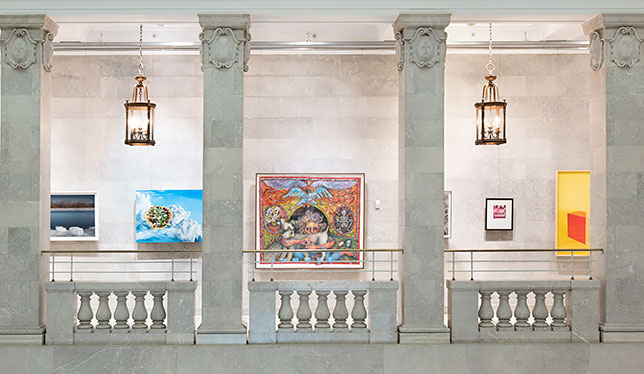The initiative includes a ‘bootcamp’ in art marketing and sales skills.
A newly launched art collection aims to support graduating students and recent alumni of Concordia University’s faculty of fine arts as they launch their careers in the competitive commercial market, while simultaneously giving the general public an opportunity to buy or rent artworks.
The Art Volt Collection (AVC) is the latest initiative of Art Volt, a platform launched in March 2020 with a variety of programs helping to help Concordia’s fine arts alumni as they transition out of school.
The new collection features about 140 artworks from 25 artists working in a variety of media, including print, painting, photography, video, ceramics and textile installations. The collection officially launched with an event at Maison du Conseil des arts de Montréal on May 17.
“It’s very important for artists to have support in the years after they graduate,” said Camille Bédard, head of AVC. “The three to five years that follow graduation are the most critical ones, because this is when artists decide if they will continue or not in their artistic path. Art Volt is there, at this pivotal moment for them.”
The not-for-profit service is supported by the Peter N. Thomson Family Innovation Fund. In 2019, the Peter N. Thomson Family Trust gave a $5.6 million gift to Concordia’s faculty of fine arts. That donation supports three areas, including the innovation fund. Each year, the AVC will make a call for submissions to acquire new art, from artists who have graduated in the past five years. Graduating students and alumni submit their work to be reviewed by a professional jury, made up of faculty, artists and curators.
Twenty-five artists were selected for the first collection, a number that could grow in the future, Ms. Bédard said. The artists’ work is showcased online, providing exposure and connections to patrons interested in renting or buying pieces, and there’s are also plans for future in-person exhibitions.
Another major component of AVC is professional development. Prior to the collection’s launch, the first group of artists attended a day and a half of “bootcamp” training, covering topics including how to properly package artwork, price pieces, and how to write a bio and artistic statement. “All the workshops that we give at the bootcamp are skills that they don’t necessarily learn at school, but they need,” Ms. Bédard said.
That focus on professional development, alongside the jury process for selection, sets the collection apart from other university initiatives that rent or sell student art. “It’s really about supporting their careers as they enter their professional life. We’re covering a wide range of skills that are part of the artistic life, but that you don’t learn while you’re at school,” Ms. Bédard said. “Art Volt is somewhat of a transition between university and real life.”
One of the artists in the first collection is Alexey Lazarev, a Montreal-based multidisciplinary visual artist who graduated from Concordia in 2019. He first participated in the Art Volt platform’s workshops and presentations before successfully submitting his work to the collection. A few of his pieces sold at the launch event, and a few more have sold through the collection’s website.
“Participating in a program like this has helped me understand the realities of the business, what it takes to be an artist, and to have some sales and make some money. It’s also good for visibility and to make new connections,” Mr. Lazarev said. “I think more universities should do a program like this; it really adds value.”
While the program’s model is unique to Concordia, Ms. Bédard sees opportunity for other universities to adapt it to meet their own needs. “I would suggest thinking, what do your artists and students need, in terms of making it into the art world? What can you offer them to help them? Maybe it’s providing them with skills and certain tools, or maybe it’s exposure,” she said.
Already, the collection has helped showcase student artists to the broader university community by providing opportunities to buy or rent original art. “There are lots of offices in universities but there was previously no way to have artworks by students in those offices,” Ms. Bédard said. “With the collection, we’ll bring artworks of Concordia students into Concordia offices, instead of having just random artworks.”
Anyone can purchase or rent artwork from the collection, but first they have to become a member of the AVC. Annual memberships start at $25, and philanthropic donations of $250 or more include automatic membership in the collection, alongside other perks. Artists set their own prices for their pieces, and the AVC takes a 30 per cent commission on sales, which Ms. Bédard said is lower than the industry standard of 50 per cent.
Already, plans are underway to expand what is available through the AVC so that graduating students and alumni from all nine departments in Concordia’s faculty of fine arts are eligible for transitional support. Acquiring a theatre play is not the same as acquiring a painting, Ms. Bédard said, so the focus will be less on buying and selling and more on providing artists with increased visibility and connections in their fields.
One way to do that is through partnerships. For example, performances will take place this August and September featuring the work of Concordia students in dance, visual arts and theatre at Art POP, the visual arts segment of the POP Montreal International Music Festival.
“The collection has just started, and already there are so many more ideas that we have in mind to develop,” Ms. Bédard said. “Having access to that visibility and exposure is really key.”
























